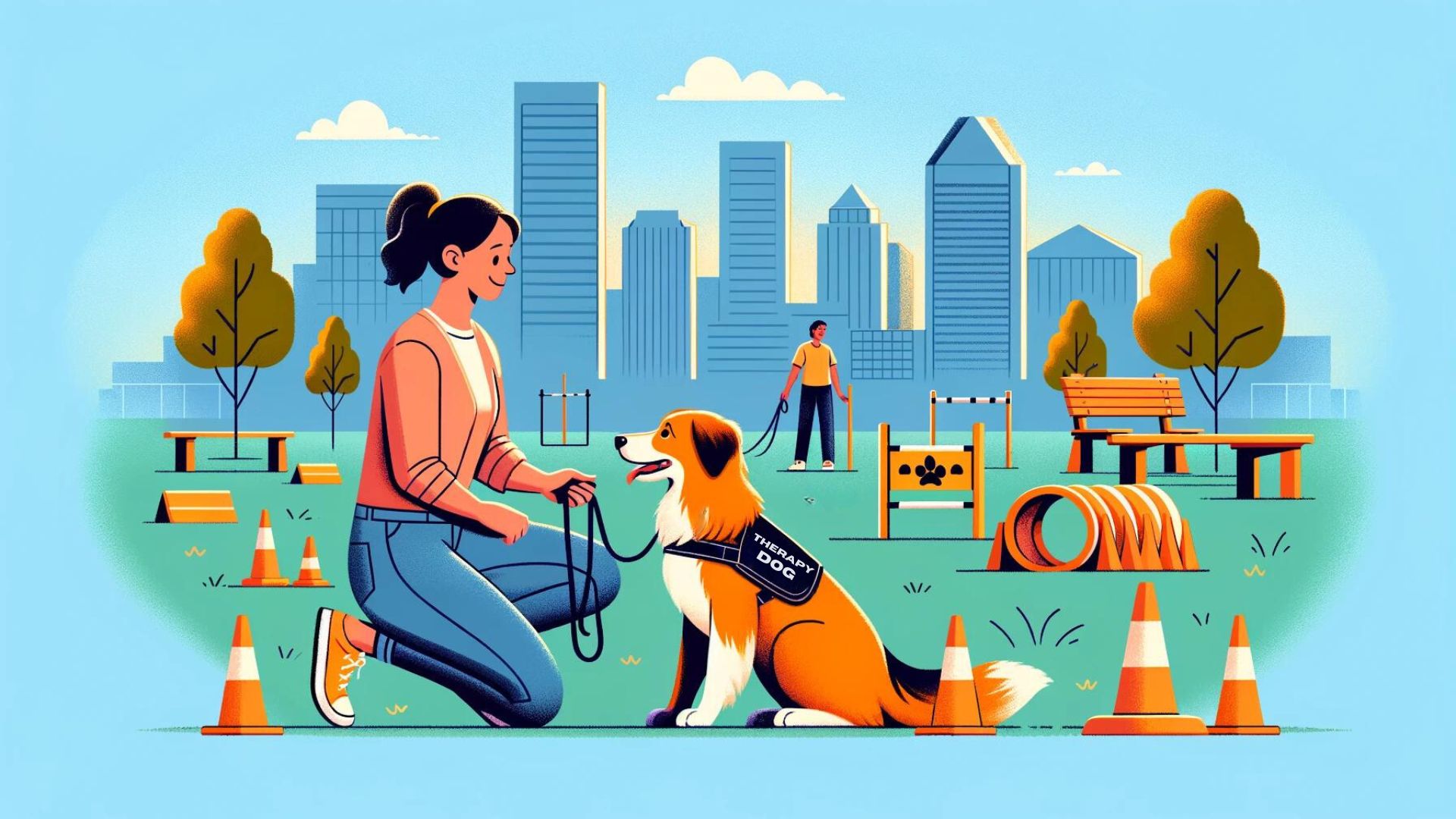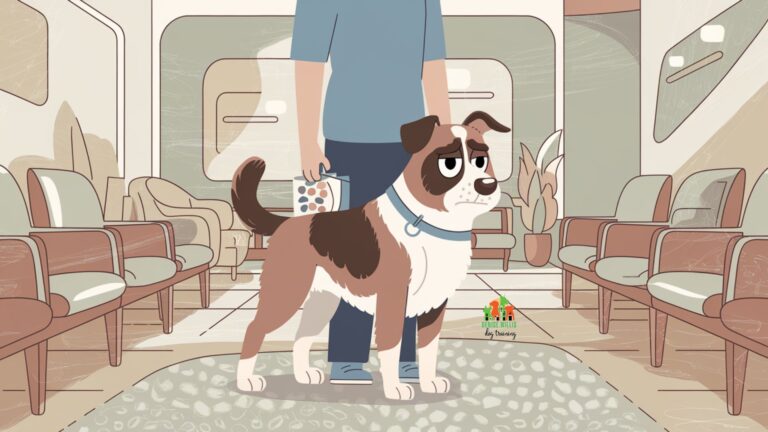Finding the Best Therapy Dog Training in Baltimore
📍 Service Area Notice: DW Dog Training provides in-person training services exclusively in the Greater Baltimore area. While our blog content is designed to help dog owners internationally, our hands-on training services are locally focused. For readers outside our service area, we hope you find value in our articles and welcome you to reach out with questions!
Therapy dogs have become an increasingly common sight in healthcare facilities, schools, and communities across Baltimore and the surrounding areas. With their friendly demeanor and comforting presence, these highly-trained pups are able to provide physiological and psychological benefits to those in need. From reducing feelings of isolation in seniors to motivating children to open up during therapy sessions, therapy dogs and their handlers are making a real difference in people’s lives.
But not just any dog can become a registered therapy animal. Therapy dogs require specialized obedience training and socialization to ensure they have the skills, focus, and temperament required for this important work. By investing time into a quality therapy dog training program, you’ll be preparing your beloved companion for their future helping career while strengthening your communication and bond along the way.
Whether your goal is to have your dog certified for regular visitation at local hospitals or to simply bring more comfort and joy to your personal interactions, finding the right trainer can be key to your success.
Keep reading to learn all about therapy dog training in Baltimore. Learn what skills your dog needs to the steps for certification. With the right guidance, your best friend may soon be sporting an official therapy dog vest and bringing smiles to the faces of those needing their support the most.
What is a Therapy Dog and How are They Used?
Before diving into the various therapy dog training options around Charm City, let’s make sure we have a clear understanding of what exactly therapy dogs are and what type of work they perform.
Therapy dogs are trained, registered, and insured dogs and handlers who volunteer to visit hospitals, nursing homes, schools, disaster sites, and other facilities. Their role is to provide psychological and physiological comfort – whether it’s through petting, playing, or just having a dog to talk to. Some of the many proven benefits of therapy dog visits include:
- Reduced feelings of isolation and loneliness – Therapy dogs promote social interaction between individuals and facilities that may have limited personal interaction. Their presence helps stimulate conversation and companionship.
- Increased motivation and participation – Children and adults are often more motivated to participate in rehabilitation exercises or therapy sessions when a therapy dog is present.
- Lowered stress levels – Interacting with therapy dogs has been clinically shown to lower stress in patients and residents dealing with emotional or physical trauma. The act of petting a therapy dog can even help lower high blood pressure.
- Fostered emotional wellbeing – Therapy dogs provide unconditional affection and comfort to those dealing with grief, chronic illness, depression, PTSD, and other significant life challenges.
So, in summary – therapy dogs and their certified handlers volunteer their time to visit healthcare and community facilities in order to provide comfort, affection, stress relief, and companionship to those in need.
Difference Between Therapy Dogs, Service Dogs, and ESAs
It’s easy to get therapy dogs confused with service dogs or emotional support animals (ESAs), but these types of assistance dogs have very distinct purposes, training, and access rights. Here’s a quick overview:
- Service Dogs: Service dogs are highly trained to perform specific tasks that help to mitigate their disabled handler/owner’s impairment or medical condition. Common types of service dogs include guide dogs for the blind, hearing dogs for the deaf, mobility dogs, seizure alert/response dogs, and psychiatric service dogs. Service dogs have full public access rights under the Americans with Disabilities Act.
- Emotional Support Animals: ESAs provide passive comfort and companionship to their owners who have an emotional or mental disability. ESAs do not need specialized training, but they do need to be well-behaved. They help their owners manage conditions like depression, anxiety, and PTSD. ESAs have access rights to live in housing situations that normally prohibit pets, and they can fly with their owners in the cabin of an airplane if certain steps are taken.
- Therapy Dogs As outlined above, therapy dogs and their certified handlers volunteer to visit healthcare facilities, schools, disaster sites, and other institutions to provide psychological and physiological support to those in need through affection and interaction. They receive obedience training and socialization but do not perform physical tasks to help a disabled handler. Their access rights are limited to the places they volunteer.
So, in summary:
- Service dogs assist their disabled handler/owner with trained tasks
- ESAs provide emotional comfort for their owner with their presence
- Therapy dogs volunteer with their certified handler to comfort institutional patients and residents
Understanding these key differences is important so you pursue the right type of training for your goals with your dog.
Now, let’s explore some of the top facilities providing therapy dog preparation in the Baltimore metro area.
Table 1: Common Commands Taught to Therapy Dogs
| Command | Description |
|---|---|
| Loose Leash Walking | Promptly returning to the handler when called |
| Sit / Down Stay | Maintaining sit or down position despite distractions |
| Come | Resisting the temptation to approach/interact with external stimulus |
| Leave It | Maintaining attention contact with the handler despite activity |
| Place | Calmly settling on a designated spot like a dog bed |
| Focus | Maintaining attention contact with handler despite activity |
Key Skills and Requirements for Therapy Dogs
Let’s explore the baseline temperament and skills therapy dogs require. Excellent training can shape and improve much of the needed behavior, but some elements are more inherent to a dog’s genetics and natural disposition. Characteristics to consider include:
Inherent Traits and Instincts
Most organizations require therapy dogs to be at least one year of age. Prior to training, some inherent traits correlated with therapy dog success include:
- Naturally affectionate and outgoing with all types of people
- Enjoys physical touch like petting, hugging, or brushing
- Comfortable around strangers and new environments
- Loves meeting and interacting with new people
- Confident personality without being overly exuberant
- Eager to please handlers and trainers
Puppies often seem like the perfect therapy dog candidates with their endless energy and unbridled excitement leaning into everyone they meet. But remember, certified therapy dogs need a rock solid “off switch” allowing them to remain calm despite stimulating environments and engaging requests from strangers to play or cuddle.
With age, continued socialization, and focused training, dogs can develop the needed composure and self-assuredness for visitations; but, some breeds are naturally more predisposed towards reserved intensity than others.
Required Baseline Obedience
In order for trainers to begin actively shaping therapy visitation skills, dogs must first demonstrate competency with basic obedience and leash handling including:
- Loose Leash Walking: The ability to walk next to handlers without pulling allows therapy dogs to safely and politely navigate facilities without posing a tripping hazard or needing physically restrained. As they graduate to greeting and interacting with patients and residents during visits, loose leash skills ensure everyone stays safe.
- Settling on Cue: Therapy dogs must be able to relax and remain settled even with activity swirling around them. Comfortable down stays and impulse control are key. When visiting busy hospital rooms or bustling classrooms, they’ll need to know how to avoid underfoot without constant reminders.
- Responding to Commands: Whether it’s the basic cues like sit, stay, down, come, wait or specialized tricks to entertain audiences, therapy dogs need to respond promptly to their handlers’ instructions so visits can go smoothly, especially with fragile patients.
- Disengaging Politely: Despite children pleading endlessly for “just one more” game of fetch down the hallway or patients offering endless pets and treats from their beds, certified therapy dogs must be able to politely walk away upon their handler’s command without hesitation. Impulse control is key for visit safety and future access.
This base-level willingness to follow directions in distracting environments demonstrates the trainability needed to actively develop a dog’s therapy visit skills.
Advanced Obedience and Socialization
Once the fundamentals are in place, therapy dog training programs can shift focus to shaping behaviors like:
- Focus and attention: Maintaining engagement with handlers despite requests for affection from others
- Body handling: Allowing all types of touching like hugs, pets, brushes, and exams without sensitivity
- Equipment and medical device desensitization: Remaining calm around wheelchairs, canes, oxygen tanks, abruptly moving beds, loud machinery, and more
- Rider stability: For larger dogs, allowing patients and residents to gently lean on them for support
The preparation is extensive, but through professional direction, extensive practice, and positive associations, therapy dog teams can proudly refine the skills needed to safely and effectively support institutional patients and residents who benefit immensely from their visitation.
Table 2: Typical Therapy Dog Certification Process
| Phase | Description |
|---|---|
| Application & Records | Submit handler application, therapy organization forms, veterinary records |
| Skills Evaluation | Assess obedience, facility/medical handling, stranger interaction |
| Specialized Training | Equipment desensitization, distraction proofing, visit simulations |
| Public Access Test | Evaluate real-world skills and ability to ignore stimuli |
| Visitation Registration | Designate visit facilities, minimum requirements, identification access |
Typical Certification Process for Therapy Dogs
While facilities and registration differ between organizations, most legitimate establishments will evaluate prospective therapy dog teams on some combination of skills, aptitude, manners, and real-world exposure before allowing active visitation. Common steps include:
Initial Evaluation
- Baseline obedience and leash handling assessment
- Interaction evaluation like petting acceptance
- Review of medical history and veterinary records
Specialized Therapy Training Classes & Socialization
- Equipment desensitization
- Advanced distraction proofing
- Practice visits and stimulating handling
Final Evaluation
- Simulated visits with strangers and medical equipment
- Public access evaluation
- Identification of any ongoing areas needing improvement
Post-Certification
- Minimum visit requirements
- Routine training refreshers
- Opportunity to register for additional privileges like animal-assisted therapy roles
Reputable facilities want to ensure therapy dog teams have all the needed skills, experience, and oversight before allowing entry into fragile medical environments. Paying for credentials without proper vetting undermines the access rights and acceptance of legitimately registered therapy animal teams that have worked extensively to secure through professional associations that uphold rigorous standards.
Invest time into quality training, socialization, practice, and evaluations so your therapy dog can safely and effectively elevate the days of those needing their comfort and care.
Unleash Your Dog’s Healing Potential
Therapy dogs offer immense comfort and joy to people facing health challenges of all varieties. By registering with a professional therapy dog organization after certification from a qualified trainer, you and your emotionally intuitive canine can make all the difference during someone’s hard day.
If you believe your dog has the perfect temperament for touching hearts and bringing smiles as a therapy dog, be sure to pursue high-quality preparation courses with reputable Baltimore area trainers like those profiled above. With their guidance coupled with your dedicated practice, soon your beloved companion could be bringing their own brand of medicine to those needing their comfort and care the most.
Key Takeaways on Therapy Dog Training
- Therapy dogs and their certified handlers visit facilities like hospitals, schools, and nursing homes to provide psychological and physiological support through affection and positive interaction.
- Specialized training prepares therapy dogs to confidently tolerate extensive petting, settle calmly amid chaos, respond promptly to handler direction, and disengage politely upon request.
- Reputable therapy dog registration organizations thoroughly evaluate critical skills and aptitude before allowing visits to fragile patient populations.
- At DW Dog Training, we offer private lessons tailored to ready your dog for successful therapy certification including confidence building, impulse control, facility desensitization, and real-world practice.
- Natural traits like human focus, distraction tolerance, and eagerness to please indicate good therapy pup potential, but focused preparation optimizes visitation safety and effectiveness.
- Local facilities like Fidos for Freedom and Paws and Possibilities also provide exceptional therapy dog preparation courses and resources.
- With thoughtful training and dedicated handler teamwork, your caring canine could soon be elevating spirits as a registered therapy animal volunteer.
Prepare Your Pup to Touch Lives
At DW Dog Training, our core mission is to strengthen the life-changing bond between dogs and their human partners. For many of our students, therapy certification takes that connection to an incredibly meaningful new level.
We’ve explored the main steps of therapy dog training, but I wanted to underline why this work is so powerful. Visits from registered therapy dogs literally elevate the spirits and health outcomes of institutional patients and residents in need.
Research has clearly shown:
- Therapy-dog interaction lowers dangerous high blood pressure
- Affectionate pups motivate wounded soldiers through rehab exercises
- Pediatric patients open up more with a fluffy counselor at their side
- Lonely seniors feel purpose again recounting old dog tales
While any friendly pet can offer comfort and companionship, properly trained therapy dogs amplify and sustain these psychological and physiological benefits through their bombproof composure and human focus. Handlers rely heavily on their dog’s rock-solid skills to safely navigate chaotic medical environments.
Here at DW Dog Training, we’ll prepare your devoted pup to confidently provide this healing service with care and excellence. If you believe your dog has the perfect temperament to elevate spirits as a therapy volunteer, let’s connect to outline an ideal training plan tailored to their abilities.
With preparation from skilled local providers matched to your dog’s strengths, your beloved companion could soon be improving lives as a certified therapy animal.
Let’s talk about readying your caring canine to make a lasting impact when people need it most.







